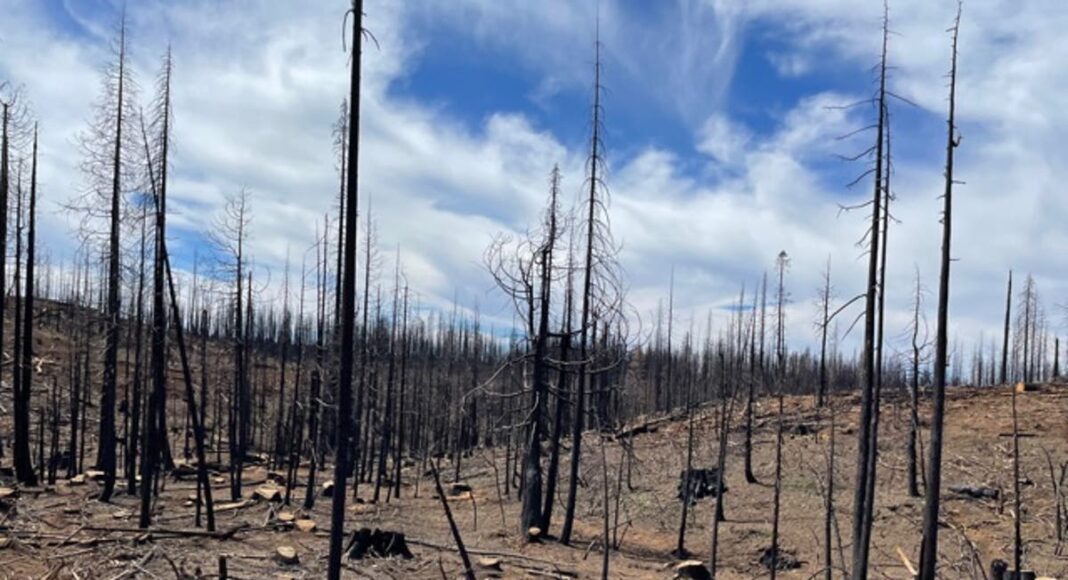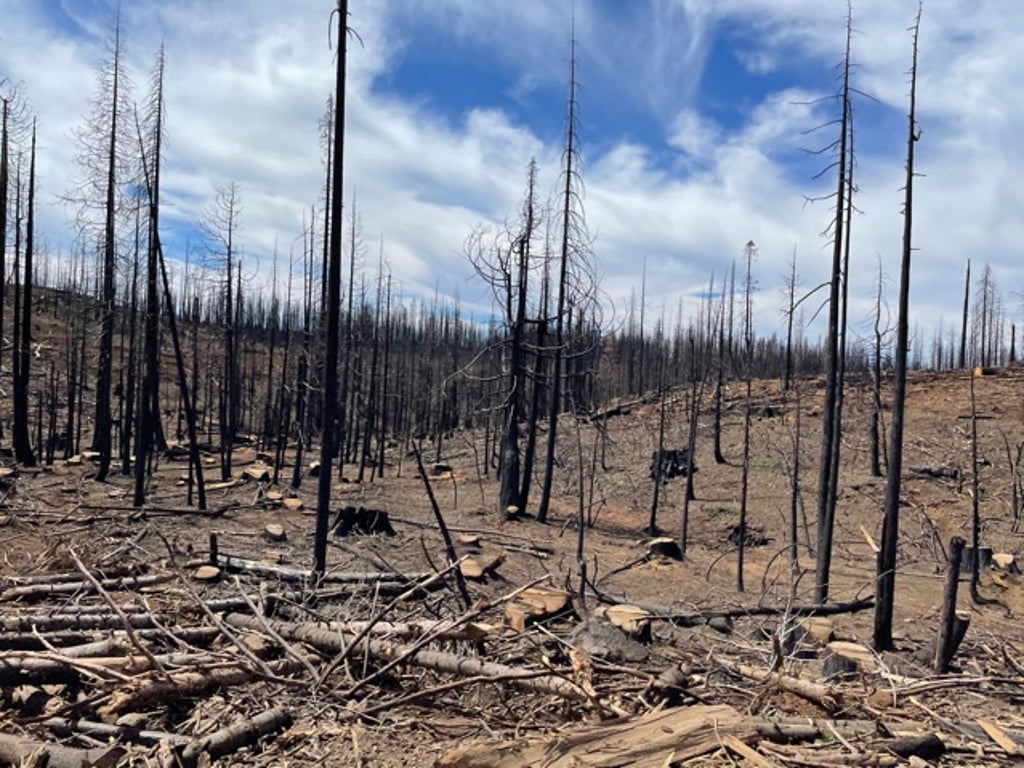Dave Daley, a fifth-generation California cattle rancher, is reliving the discovery of half a dozen cows burnt alive at a watering hole as they desperately tried to outrun the flames of a ferocious wildfire last year.
“They all died trying to get to water. I felt so bad for them, the terror of that and dying from lack of oxygen because of the smoke,” he tells The Independent.
The rancher, a professor emeritus of animal science at California State University, lost 80 per cent of his 400-strong herd, many pregnant and with calves, when fire swept through the dense Plumas National Forest last autumn.
“We brought around 100 cows home, but half then died or had to be euthanised because their hooves or udders were burnt off,” he says.
Ignited by lightning and whipped by high winds, the Bear Fire roared through acres of old-growth coniferous trees in the northern Sierra Nevada and into the towns of Feather Falls and Berry Creek.
It was part of the monster North Complex fire which, when finally extinguished after three months, had destroyed 391,000 acres and 2,400 structures. Sixteen people died, making it the deadliest fire of 2020 in California.
As the fire raged, the Daley family and some close friends spent weeks making exhaustive 20-hour daily searches through the mountains for the free-ranging cattle. It was treacherous work, with the threat of burnt trees collapsing, and scorching stump-holes in the ground.
I am enveloped by overwhelming sadness and grief, and then anger … Grieving for things lost that will never be the same
Among the search party were Dr Daley’s daughter Kate, 29, a veterinarian, and eldest son Kyle, 31, who works with his father. In one area, they found 25 dead cows and several badly injured.
“One cow was alive, but her legs had been burned off,” Dr Daley says. “My son euthanised the cow but then Kate saw a calf kick inside of her. With a knife she performed an emergency C-section. The calf’s heart was beating but couldn’t get oxygen, it had been just too long. It’s absolutely heart-wrenching.”
Our Supporter Programme funds special reports on the issues that matter. Click here to fund more of our public-interest journalism
Amid the heartache, he documented the loss of his family’s legacy in a powerful essay titled I Cry for the Mountains.
“I am enveloped by overwhelming sadness and grief, and then anger. I’m angry at everyone, and no one. Grieving for things lost that will never be the same. I wake myself weeping almost soundlessly. And, it is hard to stop,” he wrote.
The fire destroyed not only the Daley family’s cattle herd but also countless wild animals, hundred-year-old trees, and the earth’s store of native seeds for grasses and shrubs that bind the topsoil. “For a time, it destroyed hope,” Dr Daley says.
Rancher talks about the impacts of wildfire on Plumas National Forest in northern California
The Daley family’s ancestors were Irish immigrants who arrived in California during the gold rush in the mid-19th century. They made the journey to the west on wagon trains, finally settling in the Sierra Nevada and buying ranches. Diaries of those early settlers are still stored in the family home, and some of their cows’ metal bells have been passed down for five generations.
Dr Daley points out places – Lava Top, the Dodge Camp, McNair’s Saddle, Bear Wallow.
“My dad loved this range,” he says. “He was almost 90 when he died four years ago. At the same time, a big old sugar pine on our ranch died and we had it milled into lumber.
“Because the names of all these places are disappearing from history, last summer I got this wild idea to take the boards and make about 100 signs. I had just put them up and a month later the fire burned, so they’re all gone.”
The family has managed free-range cattle since before the US government designated the area a national forest in the early 1900s. The Daleys hold a permit with the federal Forest Service, along with a lease for interwoven logging corporation land, allowing cattle to wander in 90,000 acres unencumbered. The permits come with strict environmental rules, says Dr Daley. (Some environmental groups oppose grazing on public lands entirely.)
A residential area in the Berry Creek area of northern California smouldering after the Bear Fire tore through the region last September
(AFP/Getty)
As he drives in a dusty, white Ford F350, with his dog Newt dozing on the floor for company, ridgeline after ridgeline reveals a landscape of blackened, jagged tree trunks and barren soil. It feels apocalyptic.
“I have a hard time recognising the place,” he says.
The Daleys have a summer camping tradition, taking to the mountains for a July weekend each year. Dr Daley is reluctant to bring his family up here this month.
“They were here during the fire and saw the magnitude of the devastation, but I think it will crush them,” he says.
While his grief for what the fire took still seems raw 10 months later, it has also grown into resolve to do whatever he can to save what’s left.
The message is clear: quit talking and start acting.
“Let’s not study this for five years. Let’s find two or three things that we can do tomorrow,” he says.
The sense of urgency cannot be overstated. The 2020 wildfires were historic, ripping through 4.2m acres and 10,000 buildings, leaving 33 people dead.
This year looks set to see another prolonged fire season in California, and across America’s west. After a dry winter and ongoing drought, conditions are dire. This week saw a “once-in-a-millennium” heatwave in the Pacific northwest and western Canada. Temperature record after temperature record was broken, just weeks after similar conditions had hit the Golden State.
The problem is being exacerbated by the climate crisis, driven by decades of greenhouse gas emissions from burning fossil fuels.
This year so far, 3,539 fires have been reported in California, compared with 2,875 during the same period in 2020. The number of acres burned has jumped 58 per cent year on year.
The US National Interagency Fire Centre last week raised the national preparedness level to four on its 1-5 scale. Around 9,000 firefighters are already on the ground, battling blazes.
In April, Dr Daley told the US House Subcommittee on National Parks, Forests, and Public Lands: “Ecosystems have changed. Overcautious policy to correct real or perceived wrongs in stewardship resulted in decreased active management of forests, grasslands, and rangelands across the west. The result: dense canopies more prone to fire, rangelands overgrown by invasive species after abnormally hot fires, and fires that seem to be impossible to stop. The world is changing. The climate is changing.”
A firefighter watching the approaching blaze in Oroville, California after hundreds of people were evacuated from the area
(AFP/Getty)
If something can be learned from the tragedy, he says, it should be for governments to make use of solutions available to them, and work together.
Dr Daley’s suggestions are not new ones: they are informed by a knowledge of the landscape which was carried by indigenous peoples for millennia, and adopted by the settlers who came after. The use of “good fires”, known as controlled or prescribed burns, is one such idea. And where conditions can make the use of fire too dangerous, he says, livestock can be part of the solution with “prescribed grazing”.
“Cattle and sheep can do the same sort of targeted fuels management, and they do it faster and more efficiently. As a rancher, and an expert in animal science, I can tell you that the most nimble tool to address dense grasses in the most protective way is to graze these landscapes,” Dr Daley told Congress.
Read more of our Supporter Programme’s special reports
Dr Daley says that those in rural California and beyond, whose livelihoods and communities are centered on the land, have long had their generational knowledge and views ignored.
But in the face of such monumental wildfire danger, California is coming round to new ways of thinking. Cal Fire, the state’s largest wildland firefighting agency, advocates to “rapidly expand the use of prescribed fire”.
In April, California Governor Gavin Newsom signed a $536m wildfire package enabling the state to take urgent action on projects to make its landscape more resilient.
For Dr Daley’s part, he and his son have been scouting the mountains looking for viable locations for the cattle that remain. “My mom needs to have cattle up here in her 90th year,” he says.
He then recalls one bright spot during those hard weeks of the last wildfire.
“At the bottom of a canyon, my son found an orphaned baby, maybe ten days old. He followed that calf for miles until we were able to catch it,” he says.
They gave the calf to another mother when they returned from the mountains and it has thrived. It now belongs to Dr Daley’s granddaughter, ten-month-old Juniper, known as Juni.
“She was brought up here on a camping trip when she was about six weeks old before it burned,” he says. “But she’ll never know it.”




